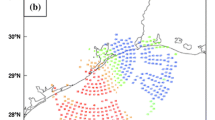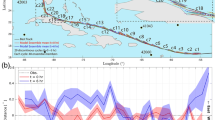Abstract
In this study, the maximum likelihood ensemble filter (MLEF) is applied to a tropical cyclone case to identify the uncertainty areas in the context of targeting observations, using the WRF model. Typhoon Sinlaku (2008), from which dropwindsonde data are collected through THORPEX Pacific Asian Regional Campaign (TPARC), is selected for the case study. For the uncertainty analysis, a measurement called the deep layer mean (DLM) wind variance is employed. With assimilation of conventional rawinsonde data, the MLEF-WRF system demonstrated stable data assimilation performance over multiple data assimilation cycles and produced high uncertainties mostly in data-void areas, for the given tropical cyclone case. Dropwindsonde deployment through T-PARC turned out to occur inside or near the weak uncertainty areas that are identified through the MLEF-WRF system. The uncertainty analysis using the MLEF method can provide a guide for identifying more effective targeting observation areas.
Similar content being viewed by others
References
Aberson, S. D., 2003: Targeted observations to improve operational tropical cyclone track forecast guidance. Mon. Wea. Rev., 131, 1613–1628.
_____, and B. J. Etherton, 2006: Targeting and data assimilation studies during Hurricane Humberto (2001). J. Atmos. Sci., 63, 175–186.
_____, and J. L. Franklin, 1999: Impact on hurricane track and intensity forecasts of GPS dropwindsonde observations from the first-season flights of the NOAA Gulfstream-IV jet aircraft. Bull. Amer. Meteor. Soc., 80, 421–427.
Burpee, R. W., J. L. Franklin, S. J. Lord, R. E. Tuleya, and S. D. Aberson, 1996: The impact of Omega dropwindsondes on operational hurricane track forecast models. Bull. Amer. Meteor. Soc., 77, 925–933.
Chou, K.-H., and C.-C. Wu, 2008: Typhoon initialization in a mesoscale model-Combination of the bogused vortex and the dropwindsonde data in DOTSTAR. Mon. Wea. Rev., 136, 865–879.
Dee, D., 1995: On-line estimation of error covariance parameters for atmospheric data assimilation. Mon. Wea. Rev., 123, 1128–1145.
Evensen, G., 1994: Sequential data assimilation with a nonlinear quasigeostrophic model using Monte-Carlo methods to forecast error statistics. J. Geophys. Res., 99, 10143–10162.
Fourrié, N., D. Marchal, F. Rabier, and B. Chapnik, 2006: Impact study of the 2003 North Atlantic THORPEX Regional Campaign. Quart. J. Roy. Meteor. Soc., 132, 275–295.
Hong, S.-Y., J. Dudia, and S.-H. Chen, 2004: A revised approach to microphysical processes for the bulk parameterization of clouds and precipitation. Mon. Wea. Rev., 132, 103–120.
Joly, A., and Coauthors, 1999: Overview of the field phase of the Fronts and Atlantic Storm-Track Experiment (FASTEX) project. Quart. J. Roy. Meteor. Soc., 125, 3131–3164.
Kain, J. S., 2004: The Kain-Fritsch convective parameterization: An update. J. Atmos. Sci., 43, 170–181.
Langland, R. H., and Coauthors, 1999: The North Pacific Experiment (NORPEX-98): Targeted observations for improved North American weather forecasts. Bull. Amer. Meteor. Soc., 80, 1363–1384.
Le Dimet, F.-X. and O. Talagrand, 1986: Variational algorithms for analysis and assimilation of meteorological observations: Theoretical aspects. Tellus, 38A, 97–110.
Lewis, J. M., and J. C. Derber, 1985: The use of adjoint equations to solve a variational adjustment problem with advective constraints. Tellus, 37A, 309–322.
Lorenc, A. C., 1997 Development of an operational variational assimilation scheme. J. Meteor. Soc. Japan, 75(1B), 339–346.
Majumdar, S. J., S. D. Aberson, C. H. Bishop, R. Buizza, M. S. Peng, and C. A. Reynolds, 2006: A comparison of adaptive observing guidance for Atlantic tropical cyclones. Mon. Wea. Rev., 134, 2354–2372.
Menard, R., S. E. Cohn, L.-P. Chang, and P. M. Lyster, 2000: Assimilation of stratospheric chemical tracer observations using a Kalman filter. Part I: Formulation. Mon. Wea. Rev., 128, 2654–2671.
NCAR, cited 2009: T-PARC. [Available online at http://www.eol.ucar.edu/deployment/field-deployments/field-projects/t-parc.]
Oczkowski M, I. Szunyogh, and D. J. Patil, 2005: Mechanism for the development of locally low-dimensional atmospheric dynamics. J. Atmos. Sci., 62, 1135–1156.
Ott, E., B. R. Hunt, I. Szunyogh, A.V. Zimin, E. J. Kostelich, M. Corazza, E. Kalnay, D.J. Patil, and J. A. Yorke, 2004: A local ensemble Kalman filter for atmospheric data assimilation. Tellus, 56A, 273–277.
Park, S. K., and D. Zupanski, 2003: Four-dimensional variational data assimilation for mesoscale and storm-scale applications. Meteor. Atmos. Phys., 82, 173–208.
_____, and L. Xu, 2009: Data Assimilation for Atmospheric, Oceanic and Hydrologic Applications. Springer-Verlag, 475 pp.
_____, D.-L. Zhang, and H. H. Kim, 2008: Impact of dropwindsonde data on the track forecasts of a tropical cyclone: An observing-systems simulation experiment study. Asia-Pacific J. Atmos. Sci., 44, 85–92.
Rabier, F., Thepaut, J. N. and Courtier, P. 1998: Extended assimilation and forecast experiments with a four-dimensional variational assimilation system. Quart. J. Roy. Meteor. Soc., 124, 1861–1887.
Reynolds, C. A., M. S. Peng, S. J. Majumdar, S. D. Aberson, C. H. Bishop, and R. Buizza, 2007: Interpretation of adaptive observing guidance for Atlantic tropical cyclones, Mon. Wea. Rev., 135, 4006–4029.
Rodgers, C. D., 2000: Inverse Methods for Atmospheric Sounding: Theory and Practice. World Scientific, 238 pp.
Skamarock, W. C., J. B. Klemp, J. Dudhia, D. O. Gill, D.M. Barker, W. Wang, and J. G. Powers, 2005: A description of the Advanced Research WRF Version 2. NCAR Tech. Note, 468+STR, National Center for Atmospheric Research, Boulder, CO, 88 pp. [Available at http://www.mmm.ucar.edu/wrf/users/docs/arw_v2.pdf.]
Tuleya, R. E., and S. J. Lord, 1997: The impact of dropwindsonde data on GFDL hurricane model forecasts using global analyses. Wea. Forecasting, 12, 307–323.
Wu, C.-C., and Coauthors, 2005: Dropwindsonde Observations for Typhoon Surveillance near the Taiwan Region (DOTSTAR): An overview. Bull. Amer. Meteor. Soc., 86, 787–790.
_____, K.-H. Chou, P.-H. Lin, S. D. Aberson, M. S. Peng, and T. Nakazawa, 2007: The impact of dropwindsonde data on typhoon track forecasts in DOTSTAR. Wea. Forecasting, 22, 1157–1176.
Yang, S. C., E. Kalnay, B. Hunt, and N. Bowler, 2009: Weight interpolation for efficient data assimilation with the Local Ensemble Transform Kalman Filter. Quart. J. Roy. Meteor. Soc., 135, 251–262.
Zupanski D., 2009: Information measures in ensemble data assimilation. In: Data Assimilation for Atmospheric, Oceanic, and Hydrologic Applications, Park, S. K., and L. Xu, Eds., Springer-Verlag, 85–95.
_____, and M. Zupanski, 2006: Model error estimation employing an ensemble data assimilation approach. Mon. Wea. Rev., 134, 1337–1354.
_____, A. Y. Hou, S. Q. Zhang, M. Zupanski, C. D. Kummerow, and S.H. Cheung, 2007: Applications of information theory in ensemble data assimilation. Quart. J. Roy. Meteor. Soc., 133, 1533–1545.
Zupanski, M., 2005: Maximum likelihood ensemble filter: Theoretical aspects. Mon. Wea. Rev., 133, 1710–1726.
_____, I. M. Navon, and D. Zupanski, 2008a: The maximum likelihood ensemble filter as a non-differentiable minimization algorithm. Quart. J. Roy. Meteor. Soc., 134, 1039–1050.
_____, D. Zupanski, S. J. Fletcher, M. DeMaria, and R. Dumais, 2008b: Ensemble data assimilation with the Weather Research and Forecasting (WRF) model: The Hurricane Katrina case. J. Geophys. Res., submitted.
Author information
Authors and Affiliations
Corresponding author
Rights and permissions
About this article
Cite this article
Kim, H.H., Park, S.K., Zupanski, D. et al. Uncertainty analysis using the WRF maximum likelihood ensemble filter system and comparison with dropwindsonde observations in Typhoon Sinlaku (2008). Asia-Pacific J Atmos Sci 46, 317–325 (2010). https://doi.org/10.1007/s13143-010-1004-1
Received:
Revised:
Accepted:
Published:
Issue Date:
DOI: https://doi.org/10.1007/s13143-010-1004-1




